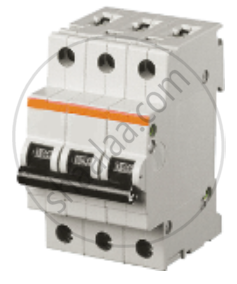Advertisements
Advertisements
प्रश्न
Tara, after completing her exams, went to her grandmother's house along with her younger brother Rahul. One day, Rahul came home after playing and switched on the fan and air conditioner. At the same time, his grandmother was preparing a milkshake for him using a mixer. Suddenly, they heard a big sound and the electricity of the house got shut down. Tara is called an electrician. He said the main reason for supply to shut down was overloading.
- What is overloading?
- Is overloading and short the same? When does short-circuiting take place?
- How can the effects of overloading be avoided?
उत्तर
- Overloading is the term used to describe the circuit's current flow when it exceeds the allowed value.
- Short-circuiting and overloading are not the same. When a live wire and a neutral wire are in direct contact with one another, a short circuit occurs.
- Overloading can be avoided by not connecting too many appliances to the same circuit at the same time.
APPEARS IN
संबंधित प्रश्न
State four most common electrical appliances based on heating effect of electric current. Why do we use finely heated platinum wire in surgery?
Why does the cord of an electric heater not glow while the heating element does?
Why is the tungsten used almost exclusively for filament of electric lamps?
Why are the conductors of electric heating devices, such as bread-toasters and electric irons, made of an alloy rather than a pure metal?
How does the resistance of a wire vary with its area of cross-section?
Why are the coils of electric irons and electric toasters made of an alloy rather than a pure metal?
Why does the connecting cord of an electric heater not glow hot while the heating element does?
An electric iron of resistance 20 ohms draws a current of 5 amperes. Calculate the heat produced in 30 seconds.
Explain why, the current that makes the heater element very hot, only slightly warms the connecting wires leading to the heater.
The current passing through an electric kettle has been doubled. The heat produced will become:
(a) half
(b) double
(c) four time
(d) one-fourth
The heat produced in a wire of resistance 'x' when a current 'y' flows through it in time 'z' is given by:
(a) x2 × y × z
(b) x × z × y2
(c) y × z2 × x
(d) y × z × x
How does the wire in the filament of a light bulb behave differently to the other wires in the circuit when the current flows?
What property of the filament wire accounts for this difference?
Two exactly similar heating resistances are connected (i) in series, and (ii) in parallel, in two different circuits, one by one. If the same current is passed through both the combinations, is more heat obtained per minute when they are connected in series or when they are connected in parallel? Give reason for your answer.
Identify the figure and give its use.

Solve the following example.
Two tungsten bulbs of wattage 100 W and 60 W power work on 220 V potential difference. If they are connected in parallel, how much current will flow in the main conductor?
The ‘live’ and the ‘neutral’ wires have potential difference of _______.
The electricity bill specifies the usage in _______.
A coil of an alloy _______ is used in electric heater cooker as a resistor.
Which of the following substance contracts on heating?
Live wire and neutral wires have a 220 V potential difference.
Write scientific reason.
A coil made up of alloy Nichrome is used in the electric heater cooker as a resistor.
Mark the correct choice
- Assertion: Electric appliances with a metallic body have three wire connections.
- Reason: Three-pin connections reduce the heating of the connecting wires.
An electric iron consumes energy at the rate of 420 W when heating is at the maximum rate and 180 W when heating is at the minimum rate. The applied voltage is 220 V. What is the current in each case?
An electric iron draws a current of 4 A when connected to 220 V mains. Its resistance must be:
The heating element of an electric iron is made up of:
Assertion: Bending of wire decreases the resistance of the electric wire.
Reason: The resistance of a conductor depends on length, thickness, nature of material and temperature of the conductor.
What is Joule’s heating effect? How can it be demonstrated experimentally? List its four applications in daily life.
An electric component used as a safety device is electric circuit is ______.
An electric fuse has a body made of ceramic and two points for connecting the fuse wire.
What are the uses of electromagnets?
What is an electric fuse made up of?
______ wire is used in the filament of the bulbs.
Name a few appliances which work on the basis of the heating effect of current.
What is a trip switch?
1 kWh is equal to ______.
In a set up the students coated iron nails with zinc metal and noted that, iron nails coated with zinc prevents rusting. They also observed that zinc initially acts as a physical barrier, but an extra advantage of using zinc is that it continues to prevent rusting even if the layer of zinc is damaged. Name this process of rust prevention and give any two other methods to prevent rusting.
An electric kettle consumes 1 kW of electric power when operated at 220 V. A fuse wire of what rating must be used for it?
Anannya responded to the question: Why do electrical appliances with metallic bodies are connected to the mains through a three-pin plug, whereas an electric bulb can be connected with a two-pin plug?
She wrote: Three-pin connections reduce heating of connecting wires.
- Is her answer correct or incorrect? Justify.
- What is the function of a fuse in a domestic circuit?
